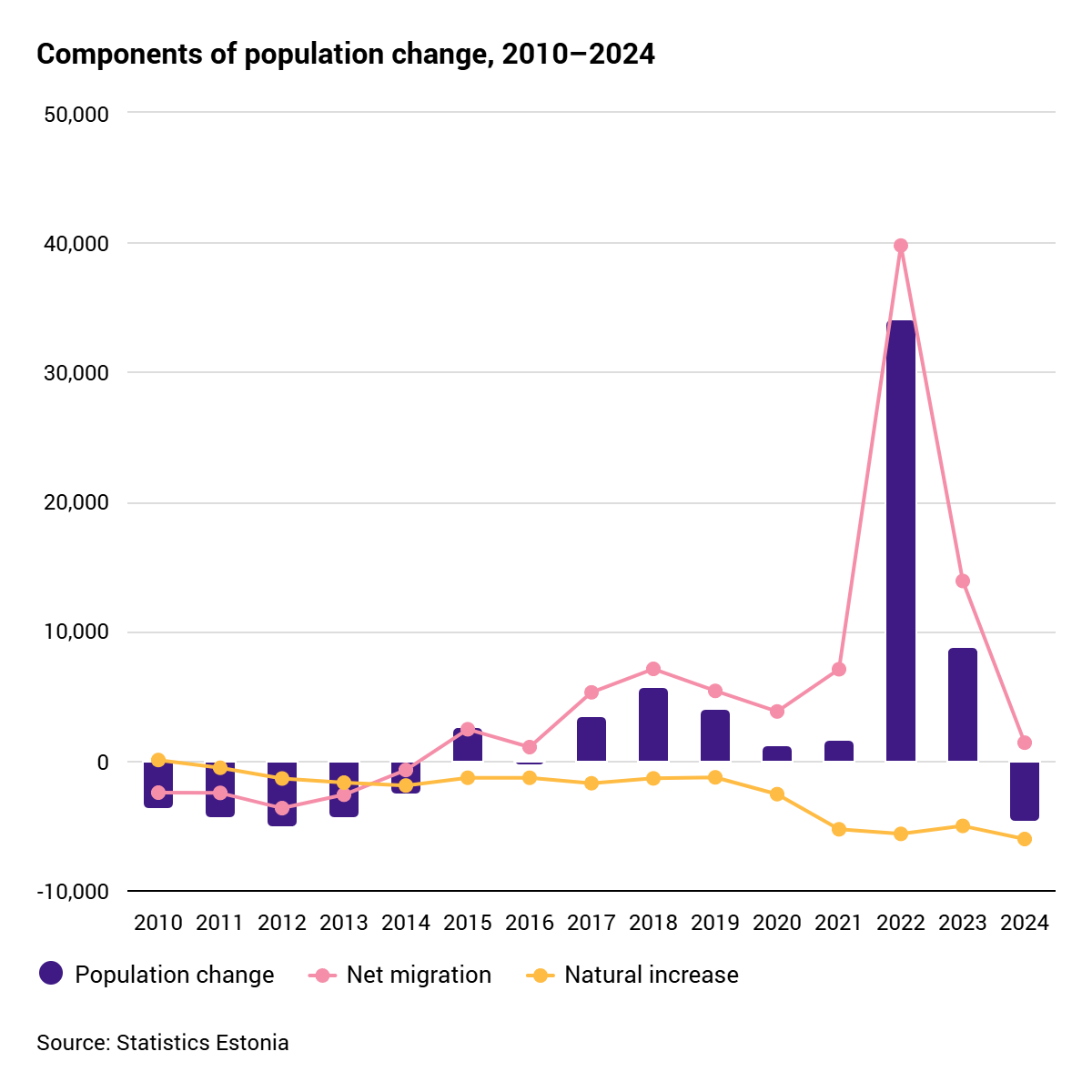1,369,995 people: Estonia's population declined
According to Statistics Estonia, on 1 January 2025, the population of Estonia stood at 1,369,995. There were 9,690 births and 15,756 deaths in Estonia last year.
Terje Trasberg, team lead of population and education statistics at Statistics Estonia, said that 18,634 persons immigrated to Estonia and 17,260 persons emigrated in 2024.
“Last year, natural increase was negative (–6,066 people), while net migration was positive (+1,374 people). As the negative natural increase deepened compared with previous years, the positive net migration could no longer compensate for it. Therefore, the population fell by almost 5,000 people last year,” she said, adding that the last time Estonia's population declined was in 2016.
There were 6,100 fewer births than deaths
For the first time in the history of Estonian population statistics, which dates back to 1919, the number of births last year was below 10,000. Compared with a year earlier, births were down by 11.5% (10,949 in 2023). “The average age of women giving birth continues to rise. Compared with 10 years ago, the age of first-time mothers has increased by more than two years and now stands at 28.9 years. This is one year lower than the EU average,” noted Trasberg.
There were 15,800 deaths in 2024, which is similar to both 2023 and the pre-pandemic period. Unfortunately, the three-year decline in the number of births continued in 2024, and deepened further in the last year, leading to a new negative birth rate record,” she stated, adding that the low birth rate is still driven by uncertainty about the future and turbulent times in society.
Immigration down, emigration up
Last year, 18,634 people migrated to Estonia and 17,260 people left. Net migration was 1,374, the lowest since 2016. “The number of immigrants is comparable to that of the period before the war in Ukraine and before the COVID-19 pandemic, while the number of emigrants, affected among other things by the emigration of Ukrainians, is the highest in the last decade,” Trasberg noted, adding that emigration last year exceeded the average of the last 10 years by 5,000 people.
Last year, 5,218 Estonian citizens arrived in the country and 6,472 left, i.e. there were 1,254 fewer arrivals than departures. 7,013 Ukrainian citizens arrived in Estonia (13,082 in 2023 and 33,217 in 2022), whereas 3,829 departed.
“Compared with a year earlier, there were half as many Ukrainian citizens arriving in Estonia in 2024 and nearly five times fewer than in 2022. However, emigration of Ukrainian citizens increased. Immigration of Russian citizens fell markedly last year. Their net migration was negative again after two decades, i.e. there were almost twice as many Russian citizens leaving Estonia as there were arriving,” the analyst explained.
What is the share of ethnic Estonians in the population?
82% (1,123,000) of Estonia's population are of Estonian citizenship, 6% of Russian citizenship, 5% of Ukrainian citizenship, 4% of undetermined citizenship, and 3% of citizenship of some other country. The number of people of Estonian ethnic nationality increased by almost 3,000, and ethnic Estonians account for 68% (935,000) of the total population. The number of ethnic Russians fell by more than 10,000.
Estonian is spoken as a mother tongue by 65% (893,000) of the population. Of Estonian citizens, 83% consider themselves ethnic Estonians and 79% speak Estonian as their mother tongue.
Data on Ukrainians
The data on migration published here cover persons who have settled permanently in Estonia (immigration) or lived permanently in Estonia before emigrating. The number of emigrants does not include war refugees who were in transit in Estonia. Persons who have been granted temporary protection are included in the preliminary population figure only if they have settled permanently in Estonia.
The revised population figure published by Statistics Estonia takes into account unregistered migration in addition to the preliminary population number published in January. The differences in methodologies are described in Statistics Estonia’s blog (in Estonian).
More detailed data have been published in the statistical database.
See also the population section on our website.
Information on the data sources and methodologies used in population statistics is available in the methodology section.
When using Statistics Estonia’s data and graphs, please indicate the source.
For further information:
Heidi Kukk
Media Relations Manager
Marketing and Dissemination Department
Statistics Estonia
Tel: +372 569 66484
press [at] stat.ee
